
Day 2 of Comic-Con is over and now, the Convention is really underway! Today’s ScriptPhD.com coverage has a heavy focus on television, and sci-fi television to be specific. Really, is there any other kind? We spent time in the press room with the stars and producers of SyFy Channel hits Caprica and Stargate Universe, our favorite geeky physics show Big Bang Theory and the exciting (first-time ever!) Comic-Con Discovery Channel unveiling of their new scripted series Reign of the Dinosaurs. As always we try to pay hommage to the roots of Comic-Con with coverage of the design tricks behind comics and graphic novels. Additionally, we provide pictorial documentation of the costumes and happenings of the Con, and our Day 2 Costume of the Day. Complete coverage under the “continue reading” cut.
From the Press Room: Stargate Universe
We were delighted to start our day with the cast of one of our favorite sci-fi shows on the air, Stargate Universe, to get a little peek into the cast’s geeky sides and what they think of their characters and show.
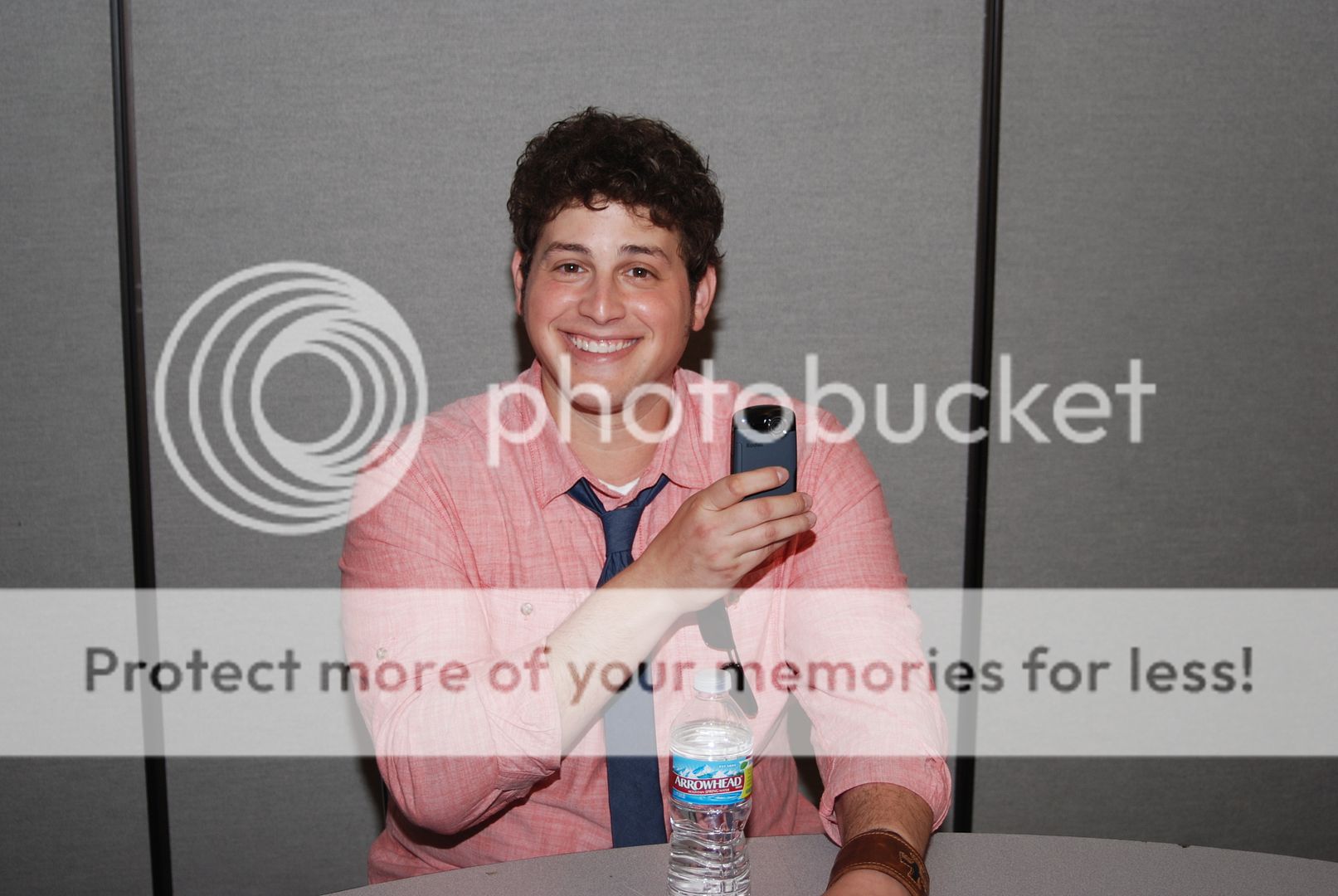
For star David Blue, playing the ship’s resident math geek Eli Wallace, this year is a completely different experience. Last year, there was so much uncertainty about the show’s acceptance and success, while this year, the cast walks into Comic-Con confident of where they are headed. He spoke of liking the idea of Eli as a hero, the show’s surrogate for the audience. Though he admits to being a geek, he was very hesitant to play the role when he heard about it, because of his previous computer nerd role on Moonlight for fear of typecasting. But Eli is not a stereotypical nerd, and experiences a lot more emotional and character growth over the course of Season 2. “I am proud to be a geek/nerd,” Blue says. “Everything from computer programming to comic books to video games.”
We were so thrilled to hear that David was a certified Grade A USDA organic geek, that we got him to proclaim so on camera for you guys:
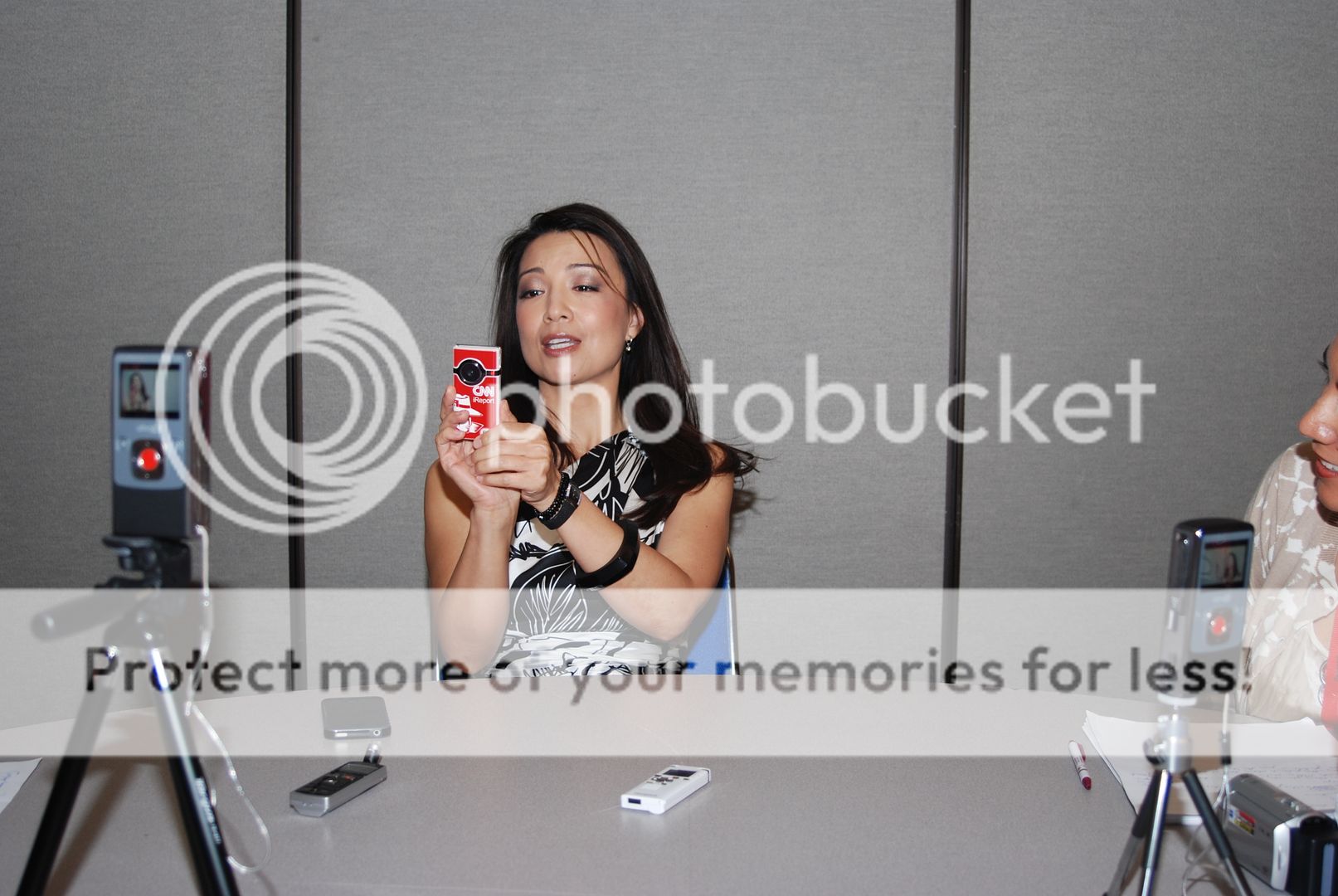
Ming-Na, whose character Camile Wray is far more controversial and decisive on the show, was asked right off the bat what she’d do differently in real life as opposed to her character. “Well, I wouldn’t be a lesbian,” the married actress quipped. Turning more serious, she said that she wouldn’t be as level-headed and calm as her character, who is often asked to make difficult, morally ambiguous decisions based on emotional issues. The fan’s response to Camile is largely a love-hate relationship. She’s gotten great response from the gay community, something that Na appreciates, but Camile’s escape from cliches or stereotypes is something that has resonated. The morally wrenching decisions are a staple of the show (and sci-fi television in general), and will only continue into Season 2. “You may not like her decisions,” says Na, “But I like her.”
From the Press Room: Caprica
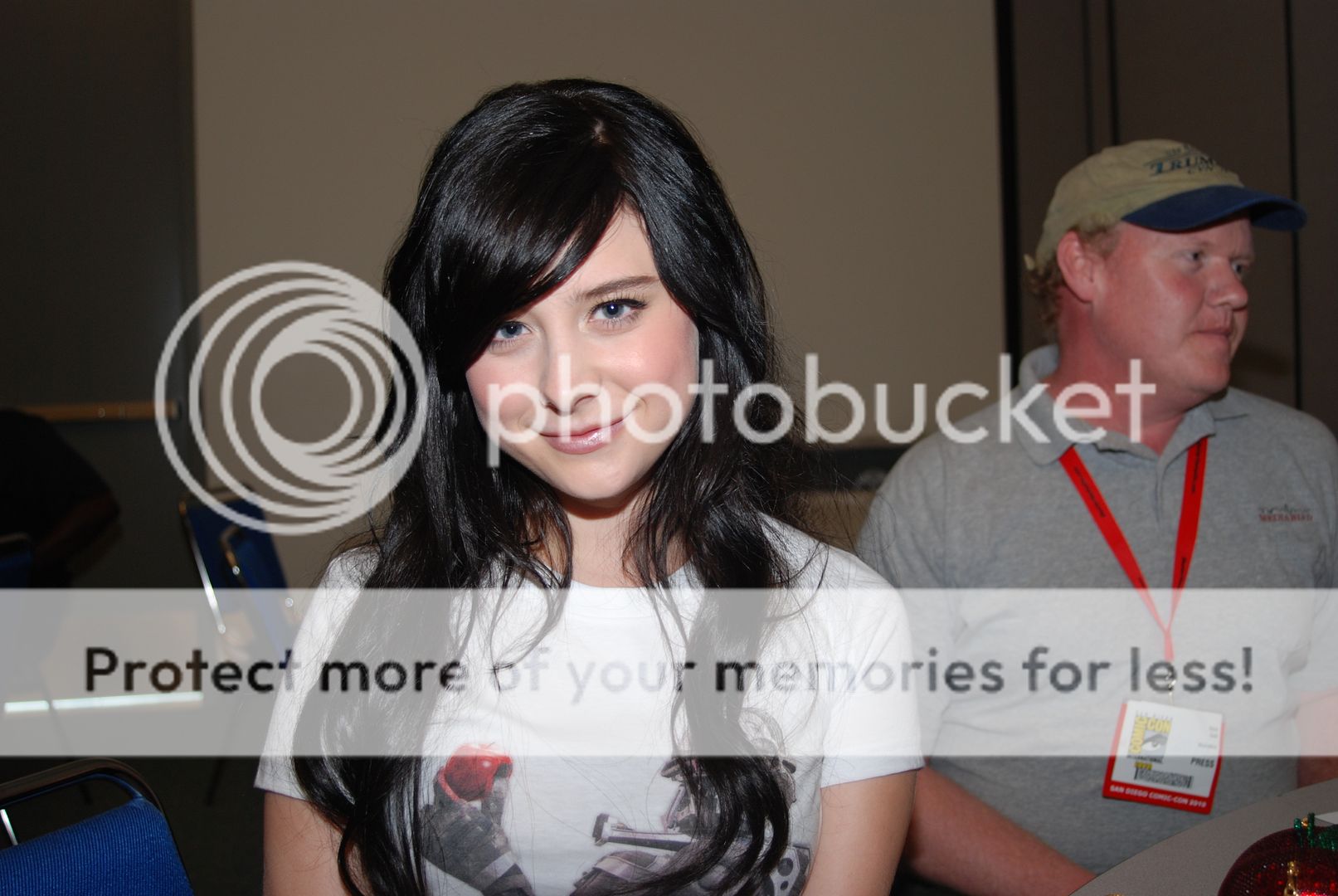
One of the most pivotal roles in the history of sci-fi television (the first Cylon) went to a girl that didn’t even really know the significance of the part. “I didn’t know what Battlestar was before I got the role,” admits Torresani, who was not a real sci-fi geek growing up. “I actually turned it down because I didn’t want to do [Caprica]. I wanted to do [Gossip Girl-type fluff]. It’s exciting now to [realize how important the role is], but it wasn’t nerve-wracking at the beginning. When I read the pilot, she was a spoiled brat, and then she gets in a robot. We didn’t know that I was going to be a Cylon. We just thought they’d use my voice and the robot’s body.” Filming the scenes as the Cylon, Torresani revealed, involves acting next to a giant green 7′ tall stick that everyone communicates with as the Cylon. She finds that the hardest part for her as an actress are scenes as the Cylon where she can’t communicate vocally, such as being lit on fire and not being able to utter a single word. “It’s really challenging. That’s something I never thought I’d have to do.”

We started our time with executive producer David Eick with a humdinger—the question we know fans would want to ask. What has been the producers’ reaction to mixed reviews and fan division of the show, most notably from the Battlestar Galactica fanbase? “We knew to expect a much greater mix [of opinions] because we knew going in that we were not going to craft it or market it as a spin-off of Battlestar,” replied Eick. Rather than containing cheeky references to BSG or inside jokes only the audience knows, Caprica is very much its own beast. He hopes fervently that as the show finds itself and its own focus, that the audience, too, would find its own way in the show. He reminded us that the early days of Battlestar were equally contentious in terms of critical and fan opinions. “The very first Comic-Con we came to for Battlestar was like George W. Bush showing up at an ACLU rally.”
In many ways, he feels more challenged by Caprica, which lacks the ticking time-clock feel of BSG. It’s a more sophisticated style of storytelling, which is based in defining the characters and the world around then, Rome before the fall. The mythology of that world is deepened as the show progresses, and how it’s harnessed by Zoey to express herself. Eick spoke of how much more graceful and elegant Caprica is visually and content-wise, with Blade Runner being a huge influence on the producers and writers. By contrast, BSG had much more of a Black Hawk Down, action feel to it.
By the way, Ron and David have a longstanding tradition of taking a drink of tequila together before either a major show launch or major seminar/Convention. In fact, David brought the bottle and we all had a little fun. Kidding. But seriously, folks, next time you think the storylines on Caprica are getting a liiiiiiiittle wacky, just remember this picture:
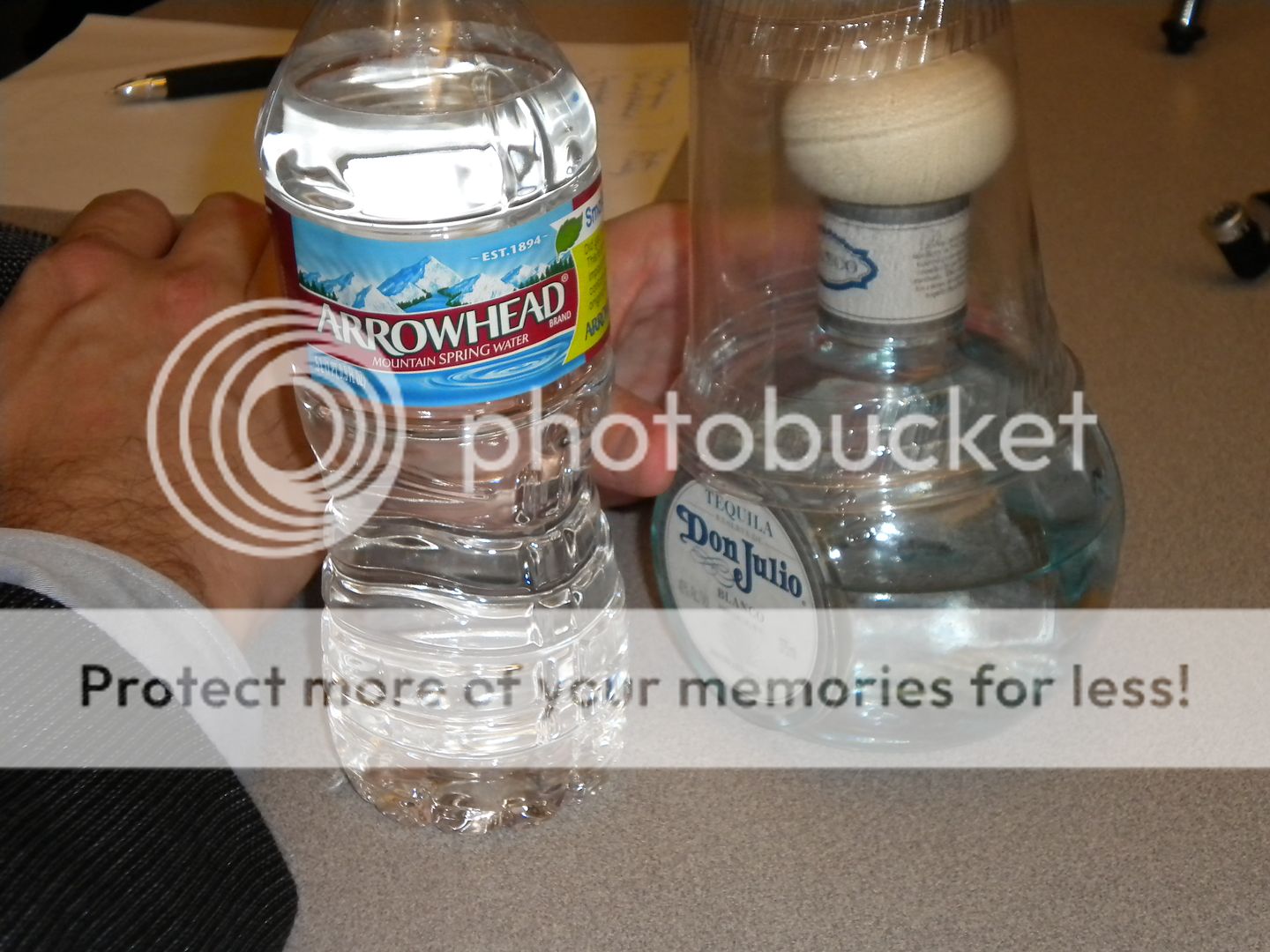
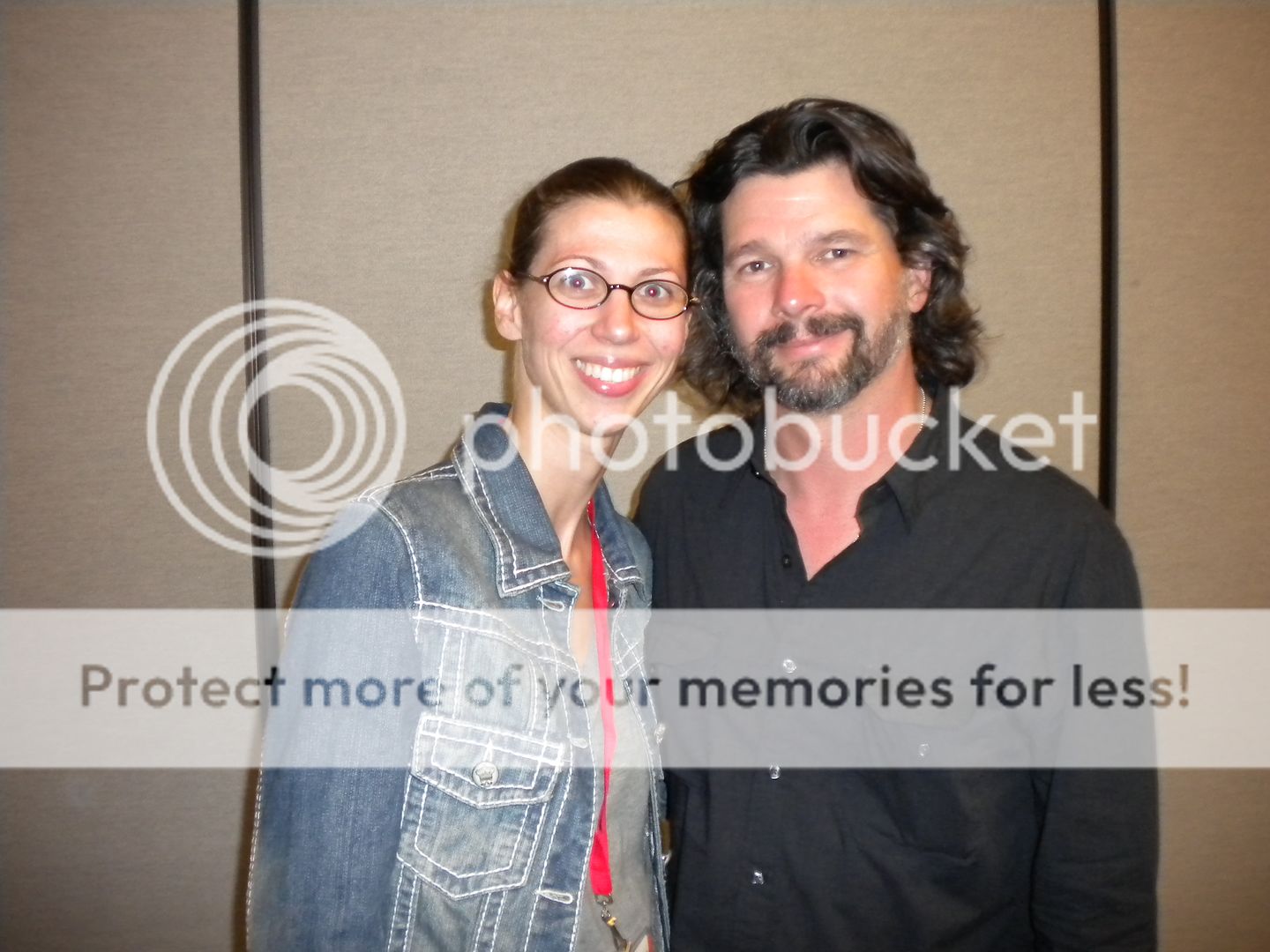
Ronald D. Moore, who made a rare media appearance at Comic-Con this year, largely echoed Eick’s comments. Caprica, he maintained is a serial, and (purposefully) as different from Battlestar Galactica as possible. In an even rarer move, Moore openly self-criticized himself for some of the early hiccups of the show. He admitted that it was hard to follow, that the story was indeed confusing, but that the show gained confidence as it went on. He predicted as strong of a build-up for Caprica as the eventual success of Battlestar Galactica. Another fun tidbit that Moore revealed was that the group marriage concept was tossed around for Battlestar Galactica, but just never found the story or the characters to make it happen.
We asked Ron about his thoughts on the current state of sci-fi and what he enjoys. “I’m probably not up to speed on a lot of other science fiction,” Moore said. “I almost avoid it now because I spend so much of my time in a science fiction world that I tend not to go there. It becomes almost like more work to watch other science fiction shows. In my brain, I’m inevitably thinking ‘How does that compare to us? And that’s their structure. How many characters do they have? I wonder what their CGI budget was.’ I haven’t watched a lot of other science fiction television for that reason.” Nevertheless, he maintains that it’s a thriving genre that will always be with us, despite the rise and fall of popularity. The one holy grail Moore hopes for is a broadcast network (read mainstream) sci-fi hit. He isn’t sure what the reason is that this popularity has remained so elusive, LOST notwithstanding. “Maybe it’s just us,” he mused. “Maybe it’s just us [the collective sci-fi geekdom], and there’s not this gigantic mass market for it in television in the way that there is a gigantic mass market for movies. Maybe that will never happen.”
We here at ScriptPhD.com hope otherwise.
From the Press Room: Big Bang Theory
If Ronald D. Moore is concerned about the viability of a basic network science fiction hit, at least he can take solace in Big Bang Theory, arguably the smartest, most successful, streamlined show about science and scientists in the history of television. We had such a fun time hanging out with the actors last year, that this year, with access to the full production team, we decided to get as much scoop from the show as possible.
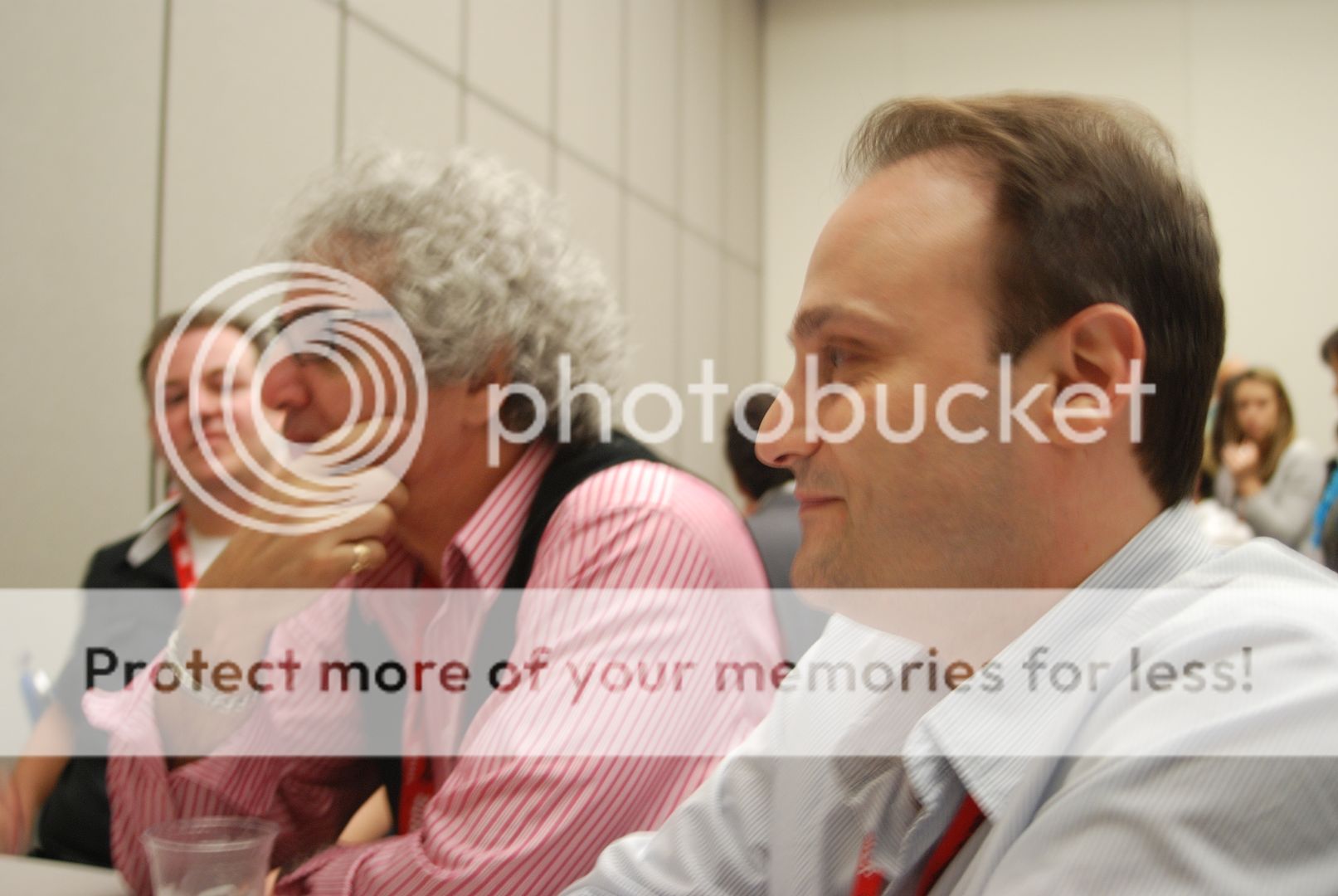

One thing fans would be surprised to learn, and the first question we asked right off the bat, is just how geeky the team behind Big Bang Theory is. Producer/writer Lee Aaronson, a self-certified comics and graphic novel geek, used to own his own comic book store. This is where a lot of the inspiration for Sheldon (and the rest of the team’s) love of geek culture comes from. They also have a close relationship to UCLA physics professor and the show’s science advisor David Salzberg. Often, they will write a line like “Hey guys, I was just working on [insert science here]” and let him fill in the blanks. We were wondering about that, too!
Geeky enough? Not even close. Showrunner and co-creator Bill Prady is a former computer programmer. He’s far more excited about Apple founder Steve Wozniak guest starring on the show than any fame or fortune that has incurred because of it. He and
co-creator Chuck Lorre maintained that the geek culture was their most important singular focus in writing the show. As one might glean from walking the halls of Comic-Con, they maintained that all geeks/nerds/scientists are not the same. There is a lot of heterogeneity amongst them, and differing, personal passions—be they Star Trek or the mathematical concepts behind string theory. And where do they get all their geeky throwaway lines? “Oh, those are all available on the internet!” And THAT is why we love Big Bang Theory.
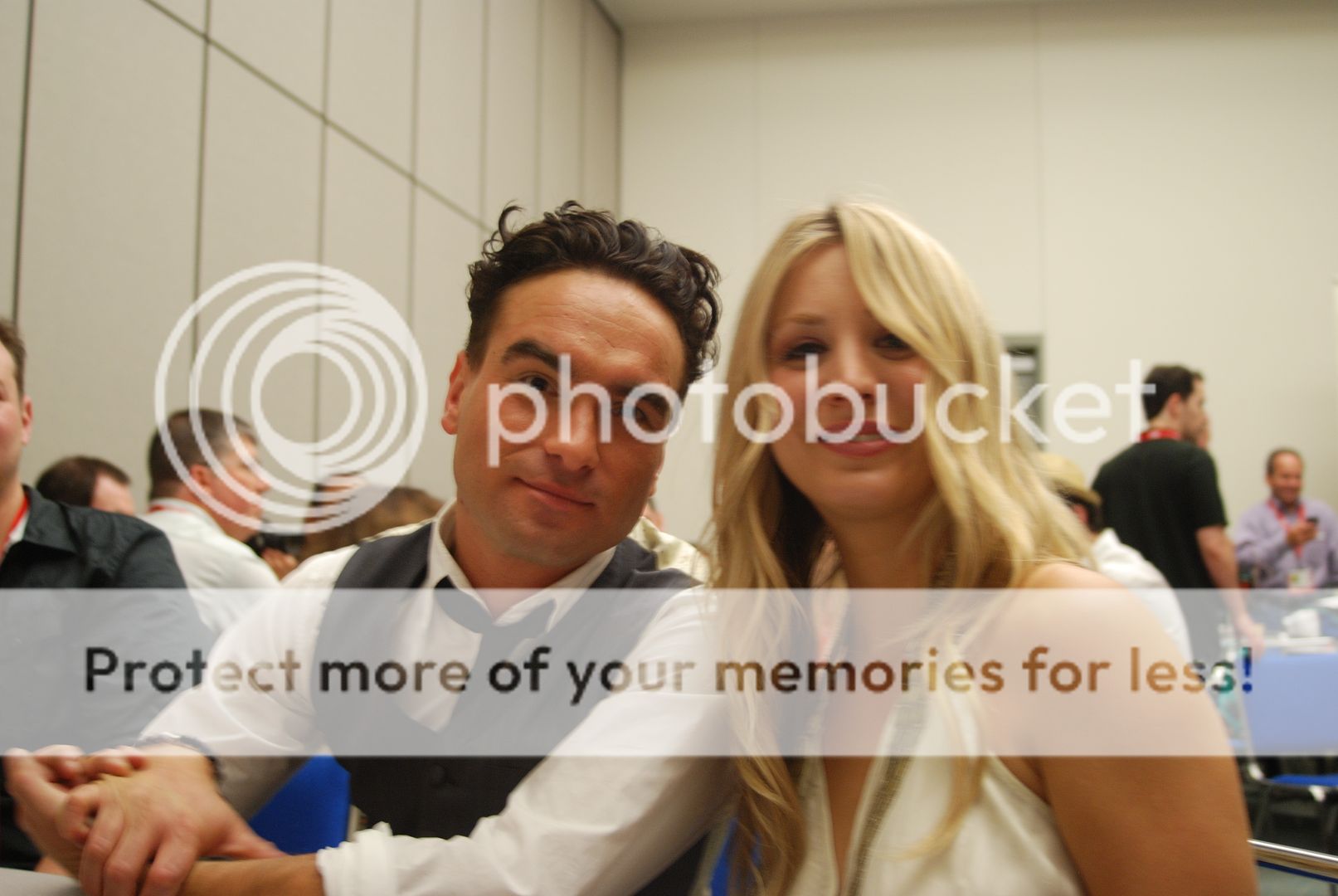

The actors themselves get right in the thick of the fun. Kaley Cuoco, playing perhaps the non-geekiest of the bunch in Penny, has nevertheless embraced geekdom. Her latest love? Her iPad! She and Johnny Galecki would both like to see a romance blossom between Penny and Sheldon (“Peldon,” joked Cuoco), but acknowledge that the road from platonic friendship to romantic involvement is filled with bumps and individual growth. Jim Parsons, who I shamelessly adore, started his time with us by telling me to shove it. He was, of course, talking about my tape recorder, but when I joked that I couldn’t believe Sheldon told me to shove it, his reply was: “And he’d tell you to shove it again and again!” Before telling Simon Helberg to bite him. Nice to know he stays in character so well!
We couldn’t leave a Big Bang Theory press room without getting our favorite superior elitist nerd to do something only for ScriptPhD.com fans. So here you have it, kids. From Jim Parsons, to you… a personal “Bazinga!”
Comics Design

One of THE most fascinating panels that we attended at Comic-Con so far was on the design secrets behind some of your favorite comics and book covers. A panel of some of the world’s leading designers revealed their methodologies (and sometimes failures) in the design process behind their hit pieces. An unparalleled purview into the mind of the designer, and the visual appeal that so often subliminally contributes to the success of a graphic novel, comic, or even regular book. We do, as it turns out, judge books by their covers.
We will be revealing each designer’s comments on their thought and art process, but are waiting for images from the panel to be emailed to us. So consider this a placeholder until we can finish this writeup and include it in Saturday or Sunday’s coverage. Stay tuned . . .
Graphic Novels: The Personal Touch
(From our correspondent Bryy Miller)

Some panels have mysterious names, some not so much. This one belongs in the latter category. There was no hidden meaning behind the phrase “personal touch.” This was all about the writers (Gabrielle Bell of Cecil & Jordan in New York, Howard Cruse of Stuck Rubber Baby, Vanessa Davis of Make Me A Woman, Larry Marder of Beanworld, Jilliam Tamaki of Skim, C. Tyler of You’ll Never Know, and moderator Shaenon Garrity of Skin Horse). More importantly and interestingly, it was about who they were. Some didn’t know who they were, others did, but they all knew one thing: that something inside of them needed to write.
Tamaki started off the discussion by stating perhaps the simplest answer of why she writes what she does, “I think that’s the only kind of book I wanna make.” Davis continued by adding that “anytime… it’s going to have a personal touch. Comics can soak up the people’s idiosyncrasies and sensibilities.” Marder, perhaps the odd man in the group, stated that even though his autobiography is a FANTASY, it still is an autobiography in the sense that it tells stories about his own feelings. Before anyone else could chime in, C. Tyler (arguably the oldest member of the panel) shot to life with an amazing amount of energy and playfulness. “I’ve taken autobiographies for granted.” she started “I know we’re at Comic-Con, but I hate superhero comics. When I read the first autobiographical comic, I was floored… it was disturbing and in a comic.” She went on to describe how she is fascinated with the idea of putting yourself out there, grabbing pieces of scraps from the table and showing us as if they were her life story – or even her creative process – in visual form. She would get extremely animated, and it really helped to humanize the element of the mysterious writer’s block and constant internal struggle to find how to portray your story. She ended her opening remarks with this, “the personal touch for me is I do it all by hand.”
Bell was the most reluctant to speak, but also, besides Tyler, the most visual. Not in the sense that she was very gesticulative or alive, but that she obviously was thinking very hard but having trouble in how to phrase her thoughts. “I try to cut my personal touch out,” she started, displaying the classic writer’s twitch of not looking directly at her audience “[I try to] make it universal. Professional.”
This instigated a very visceral response from Tyler, who on the spot tried to get into an earnest conversation with her fellow comic artist about what it means to be professional. Sadly, it didn’t last that long as Bell migrated back into thought. Cruse then brought up the point that, if your content is good, then mistakes in your craft are easily overlooked by a reader. The discussion (because calling it a panel at the end would just feel weird) had reached its time limit. Cruse gave some parting advice to young writers, “It will literally paralyze you to think of how many people have an idea similar to yours.” Marder stated that you have to fail in public. Garrity reminded everyone to heed that advice, as “Carol, Larry, and Howard have been in the comics since the seventies.”
Tyler let out a self-taunting gag.
Reign of the Dinosaurs

the Dinosaurs creative team (from left to right): Pete Von Sholly, Mishi McCaig,Tom DeRosier, David Krentz, Ricardo Delgado and Iain McCaig. (Executive producer Erik Nelson speaks on the jumbotron.)
In November of 2008, the hoi polloi at Discovery Channel approached producer Erik Nelson (Grizzly Man) with a simple request: “the ultimate kick-ass dinosaur show.” They poured enormous resources, creative and fiduciary, to create a television series that will truly break ground, both for Discovery Channel and its own medium. Scripted, yet unnarrated, scientifically stunning, yet bereft of the omniscient “talking head” paleontologist, Reign of the Dinosaurs is the ultimate exercise in “show don’t tell.” Premiering in the Spring of 2011, Reign will consist of 36 self-contained episodes erected from the art up. The stories will be chronological, detailing the rise, reign, and ultimate extinction (with a twist!) of the dinosaur species. But unlike the plethora of educational shows that cover the same topic, these will be rooted in storytelling, in treating the dinosaurs not as dinosaurs, but characters with whom we share an emotional connection. Trust me, having seen the first few world-premiere clips, you will care for these creatures, and the show will both exhilarate you and break your heart.
The true key to the success of Reign of the Dinosaurs was a dedication to amassing cream of the crop talent, formerly of Disney and Pixar, which allowed them to channel superlative animation and design talents towards an ambitious format. Along with Nelson, the team (and Comic-Con panel) consisted of renowned artists Ricardo Delgado (Dark Horse’s Age of Reptiles), Tom DeRosier (Lilo and Stitch, Mulan), self-proclaimed dinosaur nerd David Krentz (Disney’s Dinosaur, John Carter of Mars), Iain McCaig (Star Wars 1, 2, and 3), Mishi McCaig (Iron Man), Pete Von Sholly (The Mask, Darkman). Along with showing the audience their two (so-far) completed “cold open” teasers that will open episodes of the show, several of the animators simulated storyboard pitches (see picture below), just like the ones they would exchange in a writers’ room for several forthcoming episodes.
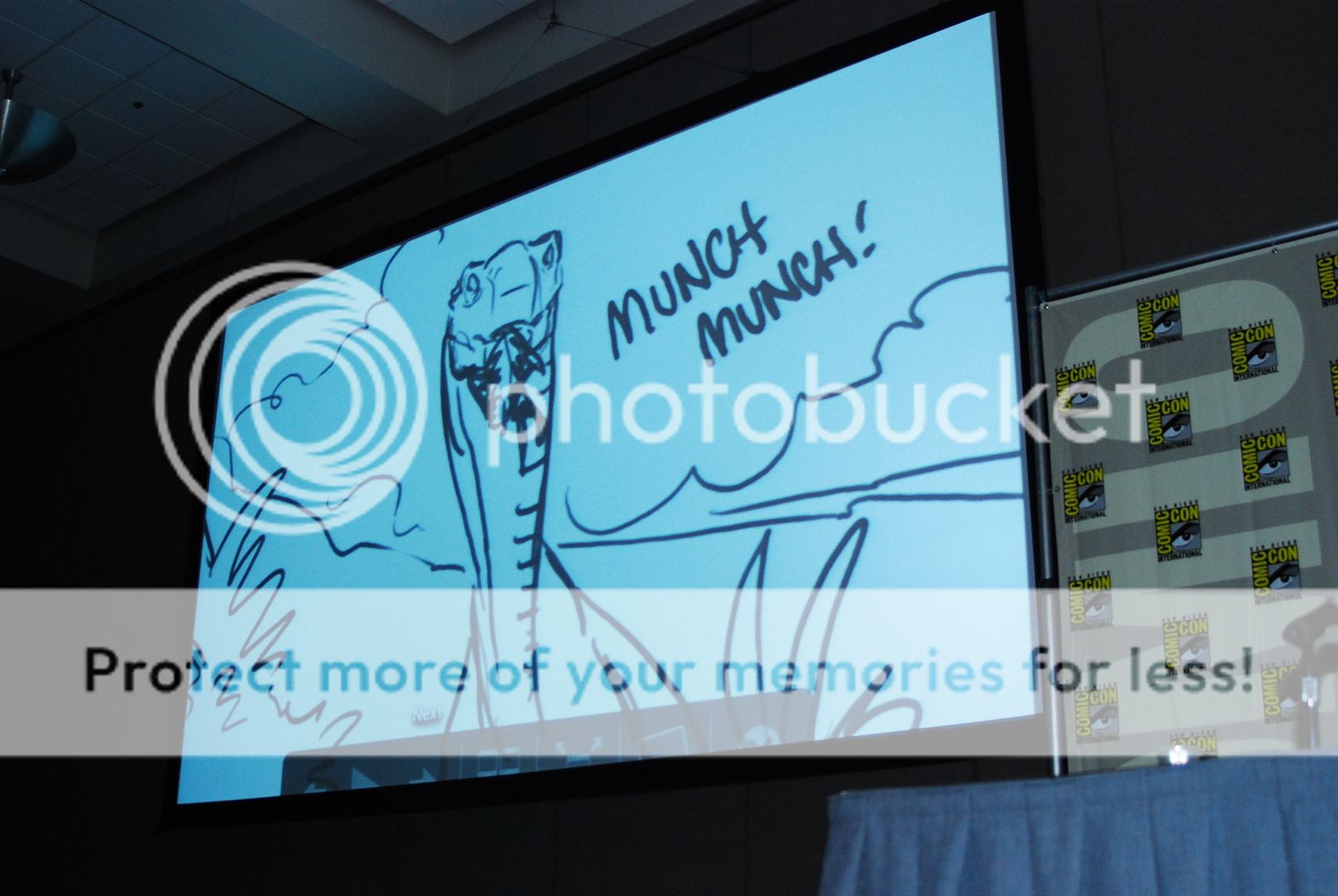
Several things impressed me upon the early viewing of Reign of the Dinosaurs, aside from the stunning art direction and well thought-out design. First of all, this show is really cheeky and funny. When the writers say that they’ll give the creatures personalities, they mean it, and it’s all done through expository action rather than showy narration. An early cold open has a dinosaur, trying to soothe her babies to sleep in the wee hours of the dawn, annoyed at the incessant chirping of a smaller dinosaur deep in the forest. Finally, she marches over and does what a dinosaur would do: bites the head off of her more annoying, diminutive co-habiting pest. Literally. Secondly, the stories pack an emotional wallop. A cinema-quality sequence shown at the end, taking place post-impact of the asteroid that ultimately killed off the dinosaurs, has the post-apocalyptic feel of Cormack McCarthy’s The Road (which the illustrator said influenced him) and visual appeal of Blade Runner. The ending, a hopeful coda on the extinction of the dinosaurs as an evolutionary stepping stone for our modern birds, had me sobbing. And then giving the panel a standing ovation.
Spring of 2011 is far away in television terms, but close enough for me to say this. Be excited, folks. Be very, very excited.
From the Press Room: Reign of the Dinosaurs

Not only did we get treated to a front-row preview of Reign of the Dinosaurs, ScriptPhD.com was extraordinarily fortunate to join the Discovery creative team for an intimate roundtable discussion panel after their panel. We were able to get enormous insight into the team’s collaborative process, storytelling aims, and dedication to balancing scientific accuracy with emotional connection, all while reinventing an entire medium. Ambitious? Just slightly.
One of the first things that impressed me upon talking to the Reign of the Dinosaurs team after their panel was their sheer dedication to, almost obsession with, “getting the science right.” Mishi McCaig and Iain McCaig spoke at length about the team’s dedication to nearing the line between science and entertainment. Hugely important to the project was the involvement of renowned University of Maryland paleontologist Thomas Holz, Jr., who cross-checks and gets pitched all the storyboard ideas. The behavior depicted in the show is speculative, but based on facts. This includes the animal’s muscle movements, how they would hunt prey, how they would interact—all aided by the paleontology knowledge of illustrator Dave Krentz. Ultimately, the team wants interest in the show to launch a more widespread educational initiative, which will include a Discovery multi-media website, and other supplementary materials to the show itself. Even when stories delve into the outrageous or fun, they’re rooted in research. A clip depicting high dinosaurs hallucinating was rooted in the marula tree, whose hallucinogenic fruit animals will eat and get high off of.
Producer Erik Nelson and illustrators Tom DeRosier and Ricardo Delgado spoke at length about the collaborative process of making the show, which they described like a TV writing room, only with animators. “Everyone’s sensibilities came together in a ‘hive mind’,” said Nelson. This visionary approach was important to the team, which is essentially trying to reinvent a TV genre. The last non-narrated, no-dialogue animated show was Walt Disney’s “Silly Symphonies” back in 1938. Needless to say, we’ve come a long way since then. The team was amazed at how constructing the dinosaurs’ stories moved them, comparing their effort to “March of the Penguins,” another simple vehicle showcasing animals that was rooted in an emotional audience response. This empathy for the dinosaurs peaks with the show’s conclusion, in which the dinosaurs die out (spoiler alert!), but which is still painted in an upbeat, survivalist way, as most geologists and paleontologists agree that modern birds are the direct evolutionary ancestors of dinosaurs.
“We’re not trying to hook you as a dinosaur person,” concluded Delgado. “We’re trying to hook you as a human being.”
Two last fun tidbits from today. Last year, on Day 3 of Comic-Con, we got geeky in the press room with our friend Barry of The Ugly Couch Show. When we saw each other again this year, we thought we’d start an annual tradition. So here it is, ladies and gentlemen. Two very tired, cranky, overworked press corps members getting silly in the press room:

And last, but definitely not least, is a very worthy Day 2 Costume of the Day. These ladies hit it out of the park. Bonus points if you can tell us which comics they’re representing:
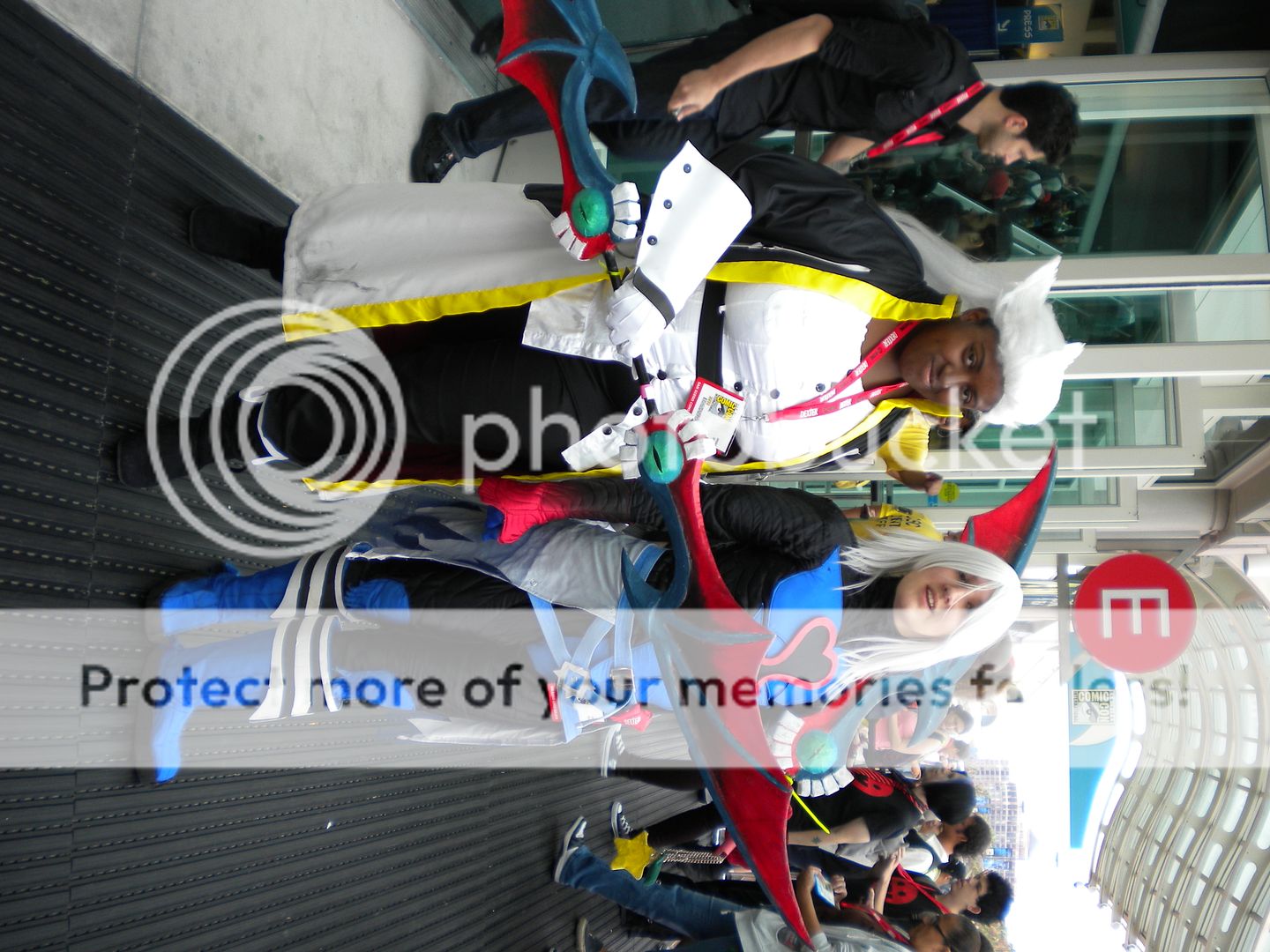
Come back tomorrow for more geeky sci-fi fun! And don’t forget to become a fan of our Facebook fan page for extra Comic-Con photos and a chance to win amazing surprise swag when we get back from San Diego.
~*ScriptPhD*~
*****************
ScriptPhD.com covers science and technology in entertainment, media and advertising. Hire our consulting company for creative content development.
Subscribe to free email notifications of new posts on our home page.
]]>
Greetings from sunny San Diego, everyone! ScriptPhD.com is in the absolute epicenter of sci-fi, comics and the illustrative arts: Comic-Con 2010. Armed with a press pass, our wonderful correspondent Brian Stempien of Lefty Films, and an industrial-sized vat of Purell, we are proud to bring you four-day coverage that spans the nexus of sci-fi, graphic arts, design, technology, film, television, and of course, the forum that started it all, comics. Day 1 coverage includes an array of panels covering the origins that drive an artist’s imagination, the future of cultural arts in a digital age, the future of space exploration with Iron Man’s Stark Industries as a model, good sci-fi, bad sci-fi, sci-fi that will change your life, and a conversation with two leading visionaries of the sci-fi genre, J.J. Abrams and Joss Whedon. ScriptPhD.com also got to chat with the stars and producers of our favorite forensics show, Dexter. Plus, we have a little secret teaser interview with a certain MythBusters star that we’ve been teasing for a good while now! As we always do at Comic-Con, we pick our Costume of the Day as part of our compete Day 1 coverage, under the “continue reading” cut.
The Spark of Imagination

What better way to begin a four-day celebration of visual imagination than a panel of distinguished artists and designers discussing the “spark” that originates imagination, how to harness concepts and ideas, and how they feel imagination informs the creative process. The panel consisted of Tony DiTerlizzi (illustrator of The Spiderwick Chronicles), Travis Knight (lead animator of Disney’s Coraline), Hellboy creator/writer Mike Mignola, Kung Fu Panda director John Stevenson, Doug TenNapel (illustrator/writer of Earthworm Jim), and moderator Geoff Boucher of the LA Times blog The Hero Complex.
Let’s be honest, creative types are weird, weird people, me being one of them. Unequivocal unanimity was reached that this very oddness, which might alienate a person from the mainstay of society, was the very fuel that drove creativity and imagination. Tony DiTerlizzi recalled being a daydreaming doodler from elementary school onward, never listening to anything his teachers or figures of authority said to him, almost inhabiting his own world. (Sound familiar, creative readers?) Travis Knight concurred, adding that spontaneity, a side benefit of idiosyncrasy, is absolutely essential to the core of imagination. Artists never really grow up; they start out as hermits hiding in basements, grow into high school kids that get shoved into lockers, and end up playing with dolls as adults. But in a way, he added, it’s wonderful and liberating to live on the fringes of society, to see things in a way that adults have forgotten how to. Hellboy creator Mike Mignola expressed amazement and awe at people wiling to be brave enough to create things for the sake of creation, even if it will never see the light of day. “Let’s face it,” Knight sighed. “There’s something wrong with us.”

Recognizing and managing productive imagination when it happens were also a popular consensus among the group. It’s really easy to come up with stuff, maintains Doug TenNapel; it’s not really a special gift or ability and we all have it to some degree. The hard part is the execution in all forms of art. There are millions of ideas that will cross through our minds that will never see the light of day not because they’re not good, but because they aren’t viable. To develop those skills of managing and presenting ideas and putting them to use so one can make a living off of them, an artist has to become an “imagination editor” that parses out the ones that matter. Thank goodness Mignola refined that skill, or Hellboy never would have seen the light of day. He’d been drawing for years at conventions and other comics gatherings, usually on-demand for fans. After endless renditions of popular figures such as Batman, the fans wanted something more original, and Mignola sketched an early, rough inception of what would become Hellboy. Later, when asked to contribute a monster to a convention comic book, he recycled the character, drawing “Hellboy” on his belt to fill a blank spot on the page. Only later, when Mignola wanted to do his own comics, would the stories and three-dimensional world grow around that original central character.
DiTerlizzi also utilizes a character as a focal point for his stories. In order to care about a world, he reminded the audience, you must first care about the character that will inhabit it. How to come up with these characters and worlds? Research, imagination, and life experience! In researching a new character for Coraline, a model, Travis Knight watched YouTube videos of runway models. His biggest regret as he walked the halls of Comic-Con was seeing so many sequels, rehashes and remakes of 1980s TV shows and recycled concepts, and such a paucity of new thinking and bold ideas. This, Knight maintained, is the driving force for the future group of designers and illustrators.
Ultimately, making movies, TV shows, and even designing is inherently a collaborative process, one that the artist must accept if they want to derive the pinnacle of their imagination. John Stevenson ended the panel by emphasizing the three key concepts of successfully harnessing imagination: collaboration and sharing (all too lacking in the modern, fearful world of design and illustration), inspiring the people you’re working with as a leader, and thanking people and showing appreciation for those that have contributed to the betterment of a project.
Be inspired. Create. Let your imaginations soar!
Iron Man and Rocket Men: Is Stark Industries an Appropriate Model for Private-Industry Space Exploration?

Iron Man was easily one of our favorite sci-fi movies from the past couple of years… and really, what was not to love? Geeky gadgets, innovative applications, and a true purview into the scientific discovery process (more on this later). More than a few mainstream publications have noted the strong ties the movie has to innovation (a couple of good ones can be found here and here). But a bigger tie-in can be argued between Tony Stark himself and the government contractors that constitute the vast majority of the space infrastructure, most notably NASA. So when we saw a Comic-Con panel devoted to exploring this very topic, we jumped at the chance to catch some of the action. Leading New Space entrepreneurs Mark Street (XCOR Aerospace) and John Hunter (Quicklaunch) joined Chris Radcliff (SD Space) and Dave Rankin (The Mars Society—San Diego chapter), with moderator Jeff Berkwits (former Amazing Stories editor) gathered to discuss what is right and wrong with NASA, and how the presence of small businesses can only help quicken the ‘space race.’
First and foremost, let’s define New Space. When we talk about Stark Industries, for example, we are talking about the most extreme example of the tech-based industry, representing the Lockheed Martins and Boeings (and to some degree NASAs) of the world—funded by the government, developing missiles, rockets, and even top-secret projects. New Space, and the small, innovative companies that are leading the forefront of its revolution, represent realistic opportunities for outer space exploration. They are Tony Stark working in his basement, on the cheap, on experiments that no one is seemingly interested in. In this case, it’s the idea of making space exploration available to ordinary people, not just military or astronauts.
The first half of the seminar consisted of a very heated argument about why more companies have not been able to take the lead in space exploration and where, exactly, NASA has stagnated so much. Mark Street pointed out the dichotomy between the entrenched business models of industry versus small companies, some of whom are already launching innovative space solutions and making a profit off of them. The established market, on the other hand, has a steady source of defined income, and no real incentive to decrease costs associated with space travel, which will take lots of investment and trial and error. Boeing isn’t building the next rocket, per se, but they are building airplanes thanks to already established rules and comfort zones. Smaller companies are ultimately able to address these problems thanks to risk-taking, failure, learning lessons, and innovating. John Hunter likened NASA to a modern March of Dimes, a philanthropic organization that was relevant back in the 60s, when it helped cure polio, but has since usurped 90% of donations for cost overhead and only 10% for actual causes that it supports. NASA’s budget of $18 billion consists of 70% “legacy” projects and 30% new innovation. What they need, he claimed, is new thinking, new risk taking. During the space war with Russia, “some of the dumbest guys I knew were looking for jobs at NASA,” Hunter maintains. “Because they knew they could study vortexes coming off of golf balls for the next twenty years.” Ouch.
To Dave Rankin, this was somewhat unfair. He invoked the sign at the X-Prize launch of Spaceship 1: “Spaceship 1: 1, NASA: 0”. To be sure, the X-Prize accomplishment was a worthy one, but NASA has been launching human beings to space stations for years, and they are still the only ones with a proven track record in the United States. Part of the problem is that because NASA is subject to political whim, it has no clear-cut focus with its identity (does it launch rockets, do basic research, innovate new technology, etc?). That lack of risk-taking at NASA is where you wind up with stagnation; it’s so big, with so many stake holders, that the sheer size lends itself to bureaucracy. The panel also brought up NASA’s two shining stars: the Jet Propulsion Laboratory in Pasadena, CA, and the Hubble Space Telescope. While JPL provides some of the world’s best robotics, such as the Mars Rover, the photography coming from outer space is simply amazing. “You can’t put a dollar value on some of what NASA does. It’s who we are as human beings, but you can’t make a profit off of it. As humans, we have to keep looking into what are the places of the universe and how did we come to be here,” said Chris Radcliffe. Quipped Rankin: “Let it not be said that government does not fund the arts.”
Take a look at a video of the first commercial launch into space:
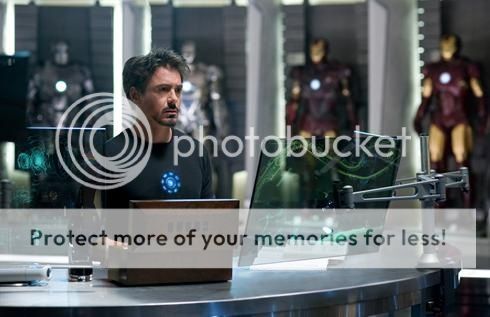
The inspiration for New Space exploration—for sticking Tony Stark into a basement—is that we need some more inspiration from space exploration than we are getting from traditional launches, and that will involve sending more people into space. Chris Radcliffe gave an example of a young engineer working at Hewlett-Packard in its early days who had the brilliant idea that computers could be more than technical devices; they could be personalized, streamlined, and made accessible to everyone. Hewlett-Packard didn’t agree, so he formed his own company and made that computer. The man? Steve Wozniak. The company? Apple. The computer? The Apple I. Like many of the companies comprising the New Space revolution, the design process in Iron Man is from top down, but the fun part is in the testing—you never quite get the process right the first time around.
Overall, the panel was very optimistic about the future of space travel and exploration, but emphasized the importance of spin-offs and small companies as a means to accomplish that. The biggest hurdles they will face is lowering prices of going to space, and overcoming the bad publicity of any first deaths that may come from the danger factor. Foreign competitors will have an even bigger role in driving our exploration. China will keep us on our toes, as they are very good at taking an idea, copying it and productionizing it. What will be the role of these companies in space exploration? Chris Radcliffe is pretty sure that space tourism will succeed, but that it will only comprise about 5% of the market. But it will be enough to drive producing vehicles and rockets and spacesuits and supplemental research off of things that will make money. The NASA CRuSR project, for example, takes existing suborbital platforms and doing science (in this case access to space for a reasonable cost) that they otherwise could not do on their own.
One of the more lighthearted moments, amidst a lot of PhD degree flaunting both from the panel and several people who asked questions, was a gentleman who prefaced his question by saying “I work in a coffee shop.” The reply from the panel: “You’re my hero!” While he respected space exploration as an ideal, he wondered whether the enormous cost of availing space to the average man might be better spent on pragmatic problems that can be solved right here and right now. Unanimously, the panel agreed that expanding human presence in space can only improve standards of living for everyone. If we wait until all our earthly problems are solved, they maintained, we’ll never do anything else.
Dave Rankin gave perhaps the best reason why New Space could be the future of exploration. “Space exploration is a forum for humanity: when we find a new space, we try to fill it.” We think Tony Stark would agree.
State of the Geek Report

From the more substantial programming of earlier in the day, we decided to devote the rest of Day 1 of Comic-Con to exploring our inner geek, with two panels looking at the best (and worst) of sci-fi in current entertainment. We started off with the “State of the Geek Report” panel, an exploration of the state of science fiction, fantasy, and horror in television and film today, and what the success of Avatar means for the future of movies. Steve Melching (The Clone Wars), Ashley E. Miller (Thor, X-Men: First Class), Steve Kriozere (Elvis Van Helsing), and Bill Hung and Todd Doogan of Digital Bits joined Geek Monthly editor and moderator Jeff Bond in discussing all things geeky in modern sci-fi.
Overall, the panel agreed that 2010 (largely carrying over from 2009) was one of the strongest years on record for sci-fi content. In some ways, we are at a peak of great sci-fi presence in pop culture and visual mediums, echoing 1982, considered by some to be the greatest year for sci-fi movies ever (Android, Blade Runner, ET, Forbidden World, The Wrath of Khan, Tron, etc). However, Bill Hunt maintained that Hollywood continues to try too hard to make every sci-fi film an “event,” and is getting excited for releases, but for all the wrong reasons. Not every film can be a blockbuster. In the past year, of the sci-fi films that got high marks from Jeff Bond, many were produced on extremely low budgets, including Moon, District 9, and the indie sci-fi film Yesterday Was a Lie. He also gave high marks to Star Trek and Avatar, which is where the panel took a big of a detour.
While Bond felt that the traditional, universal storytelling and high craft of Avatar made it a great success, Ashley Miller felt otherwise. Every dollar spent on the film was for aesthetics, and indeed, frame by frame, it is a beautiful film, including changing our expectations of what a 3D film should look like. However, as a complete work of art, it was shockingly lacking. To that, the panel brought up the point that what Cameron did with Avatar was harness 3D technology effectively, but the idea that every film now needs to be in 3D is ridiculous. Of recent releases, the brilliant Inception manages to be a challenging, engaging movie without the use of 3D technology.
Visionaries such as Christopher Nolan and James Cameron are given a lot of autonomy in their filmmaking—they are auteurists whose vision leads to the ultimate conclusion. Does sci-fi filmmaking lack for more Nolans and Camerons of the world? Autonomy, the panel decided, is earned. And not every director walking around is a Chris Nolan or James Cameron. Cameron made the original Terminator, which many feel is one of the greatest sci-fi movies of all time, on a shoestring budget. And Nolan used every penny of Inception’s mega-budget wisely. District 9 (which ScriptPhD.com loved) was shot in South Africa, with a native cast, on a very small budget. Moon, which we also liked, did all their special effects on model scale, with digital enhancements.
Ultimately, sci-fi is hurting most from studios turning everything into a “brand”: they are minimizing risk with constant remakes, but will ultimately have to swallow their tails and go towards original content at the risk of running out of material to remake. Sci-fi on television, which does not wallow in such an ignominious fate, is suffering from an embarrassment of riches. Highlights included Caprica, which invented an original, immersive futuristic world, and Stargate, which indulges in the essence of science fiction; to get the scope of wonder about other planets and life forms in the universe. (We will be joining cast and crew from both of these shows on Day 2 of Comic-Con!)
Abusing the Sci of Sci-Fi

From a discussion of the best of sci-fi, we went to what always ends up being one of our favorite Comic-Con panels, Discovery Magazine and Science and Entertainment Exchange’s “Science of Science Fiction.” Hosted by the hilarious, delightful and brilliant physicist Phil Plait (of the Bad Astronomoy blog), the panel was an equal mix of writers and scientists: Eureka creator/head writer Jaime Paglia, Battlestar Galactica and Eureka science advisor/physicist Kevin Grazier, Fringe writer Zack Stentz, and physicist/author Sean M. Carroll.
In perhaps one of the smartest ways we’ve seen yet at Comic-Con, the panel collectively provided examples of “good” and “bad” science on television and in film through clips. We’ll provide you with some of the highlights. Plait started the procession by admitting that he himself became interested in astronomy by watching Star Trek and Space:1999, and maintains that there is a lot of inspiring science in television and film, despite the bad. That said, his “worst” clip was from Armageddon, a scene Plait maintains is possibly the worst science film clip ever—Bruce Willis is supposedly on an asteroid and yet it’s raining! “Jerry Bruckheimer, you’re not in the audience are you?” He asked. “Armageddon. Worrrrrrrrrrst movie ever made!”
Paglia, bravely, picked scenes from Eureka as both his “good” and “bad” clips. The bad was a terrible attempt at an episode where nanoids have started to replicate biological organisms, while the good was an episode where Eureka made its own version of the Hadron supercollider. Quipped Stentz: “I have lived in Eureka in Northern California. Let me telll you…not filled with geniuses!”

Grazier, agreeing with Plait that Armageddon is the worst science film ever made, maintains that it has lessons of both good and bad science. In a scene showing the hypothetical impact of the impending asteroid (complete with overdramatic voiceover: “It has happened before, it will happen again!”), the shock wave of the impact is shown traveling around the Earth, which would not happen, while secondary impacts, which would happen, are omitted. The film was overly dramatic where it didn’t need to be, and yet missed out on an opportunity to show really scary science that was accurate. “It’s the only film that ever lost me in the first 30 seconds,” said Grazier. That said, the scenes showing post-asteroid tsunamis and other ramifications are so perfect, they could be a computer simulation for an asteroid impact on Earth.
Stentz, in a bit of writer’s defense, pointed out a bad scene from Fringe where the science was purposely abused in the service of an otherwise good episode. He wanted to illustrate that sometimes, you have to break the rules in order to tell the story you want to tell. Here, the writers wrote a story line where Walter’s hippocampus was “stolen” to remove his memory. To retrieve it, the team suggests implanting the memories (via the brain pieces) in the brain of someone who could interpret them. “I’m not a neurologist, but I know enough about memory to know that it doesn’t work that way. We knew that when we wrote it. We wanted the drama of a theft from someone’s brain, and how do you use them. That’s why you heard the line, ‘In theory, you shouldn’t be able to do that.’”
Carroll, ever the ambitious physicist, provided a theory, as opposed to just clips, against the philosophical backdrop of issues raised by the demands of narrative versus scientific accuracy. Take a look at the following Big Bang Theory clip of Sheldon explaining Superman and gravity:
This is the right way to think about science versus storytelling. A lot of writers are afraid of scientists because, frankly, we’re ANNOYING. We act as copy editors: “You can’t do this. You can’t do that.” But scientists are also good at telling you the consequences of existing laws, even if it ruins the romance of Superman. Science can make a story better by following this formula for conflict. On the opposite side of the spectrum, you have the mysterious “Red Matter” from this past year’s Star Trek remake. No one knew what the stuff was, how it worked, just that it was a ball, it was bad, and you had to use a hypodermic needle to handle it. It’s far more interesting if you know the rules, can explain the science, and integrate that smartly into the storyline.
A lot of times, people think science fiction means anything can happen at any time, and that’s actually science magic. The rules don’t have to be scientific rules, but good drama comes out of limitations (scientific or otherwise), characters not being able to do something and coming up with another solution for it. As a working writer in TV/film, you want people wanting clarity on one side, but on the other had, you don’t want people to feel stupid and you can’t bore them. You can introduce science and technology in a way that heightens the excitement rather than taking them back to science class. ER used a writing trick to make this happen: one line of exposition, another line of exposition (medical jargon), then an emotional line telling you what happens. Ellen Page of the recent move Inception served this purpose as the audience member—what questions would they ask of the characters in the movie. To this degree, Carroll awarded Iron Man the award for best “science” movie of recent times, not for any specific science content, but because building the suit shows the true scientific method, and that’s how it’s really done in the lab!
Our intrepid correspondent Bryy Miller also went to two very exciting panels that covered a bit more mainstream pop culture. Here is what he had to report:
Tripwire Magazine
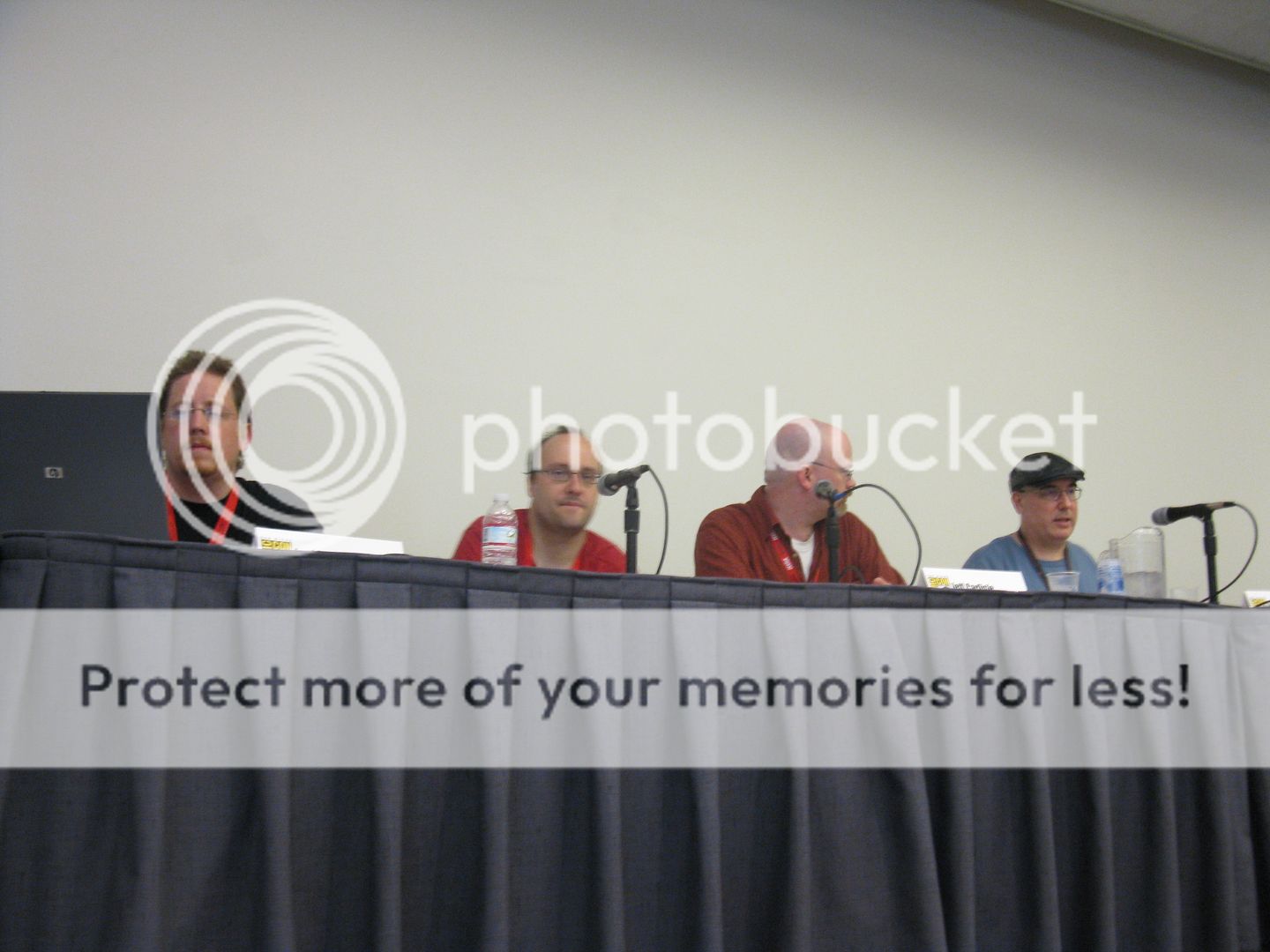
I had a theater class in high school, and we used to say that it was the most “un-schooly” class ever. It existed within the confines of the high school, but did not feel as constricting or regulated. Sitting in with the guys from Tripwire Magazine, a joint UK-American geek culture print, evoked the same feeling. It understood that the Con existed, but the speakers (Editor-in-Chief Joel Meadows, U.S. Editor Andy Grossberg, and Staff Writer Jeff Carlisle, and guest speaker Rich Johnston [editor of Bleeding Cool News]) were so aloof and full of intelligent confidence that everything seemed to fade away. They made the audience feel like they were a part of Tripwire – Joel even mocked the obscurity of their little magazine being at Comic-Con by proclaiming “welcome to the Tron panel, everyone!”
Their little magazine, starting as nothing more than fan scribblings in 1992, slowly gained notoriety over the years until they halted for a bit in 2003 due to their current publisher financially screwing them over. They got back on the horse in 2007, and since then, have gone on to catch things in geek culture such as the coveted first set visit for the superhero film, Kick-Ass. This proved to come back to teach them a further lesson in industry magazine politics, as the article was released a full year before it was assumed that it would. Tripwire covers everything in geek culture except music and gaming, and now they have set their eyes on new media such as webcomics and webserials.
“Anyone can get in, but how do you get people’s attention?” Grossberg mused, before giving Felicia Day’s The Guild as an example. A highly successful webseries about gaming, The Guild has a frothing following that has attained such levels due to catering to an audience that already surfs the web daily, and that would most likely consist of gamers. But Grossberg has another theory, and it is much more pernicious in nature as well as much harder to digest. “You know what they expect [newspaper] editors to do?” Grossberg asks Meadows, talking about the changing roles of businessmen in the digital age. The Editor-in-Chief simply replies: “Everything”. Turning to us, Andy Grossgberg comes to the summary of the thought that he started with The Guild, and that is that old media is dying because nobody has an attention span. He then goes on to lay out all of the various people involved in the making of a print comic versus the one or ones involved in making a webcomic. Carlisle then speaks up with his input on if you want to make money as a comic creator in the age of new media, “do a webcomic … everything will be the same thing [as far as everything being digital].”
This all went over fairly well until they asked to see a show of hands concerning who knew what they were talking about. Apparently, I was the only hand that shot up. It seems that the digital divide is still there, which scared me, considering we just spent an hour talking about how fast the winds of change are blowing. The panel ended with a heated discussion over which comic adaptation is the most “meta” because after all, this is Comic-Con.
EW Visionaries: J.J. Abrams and Joss Whedon
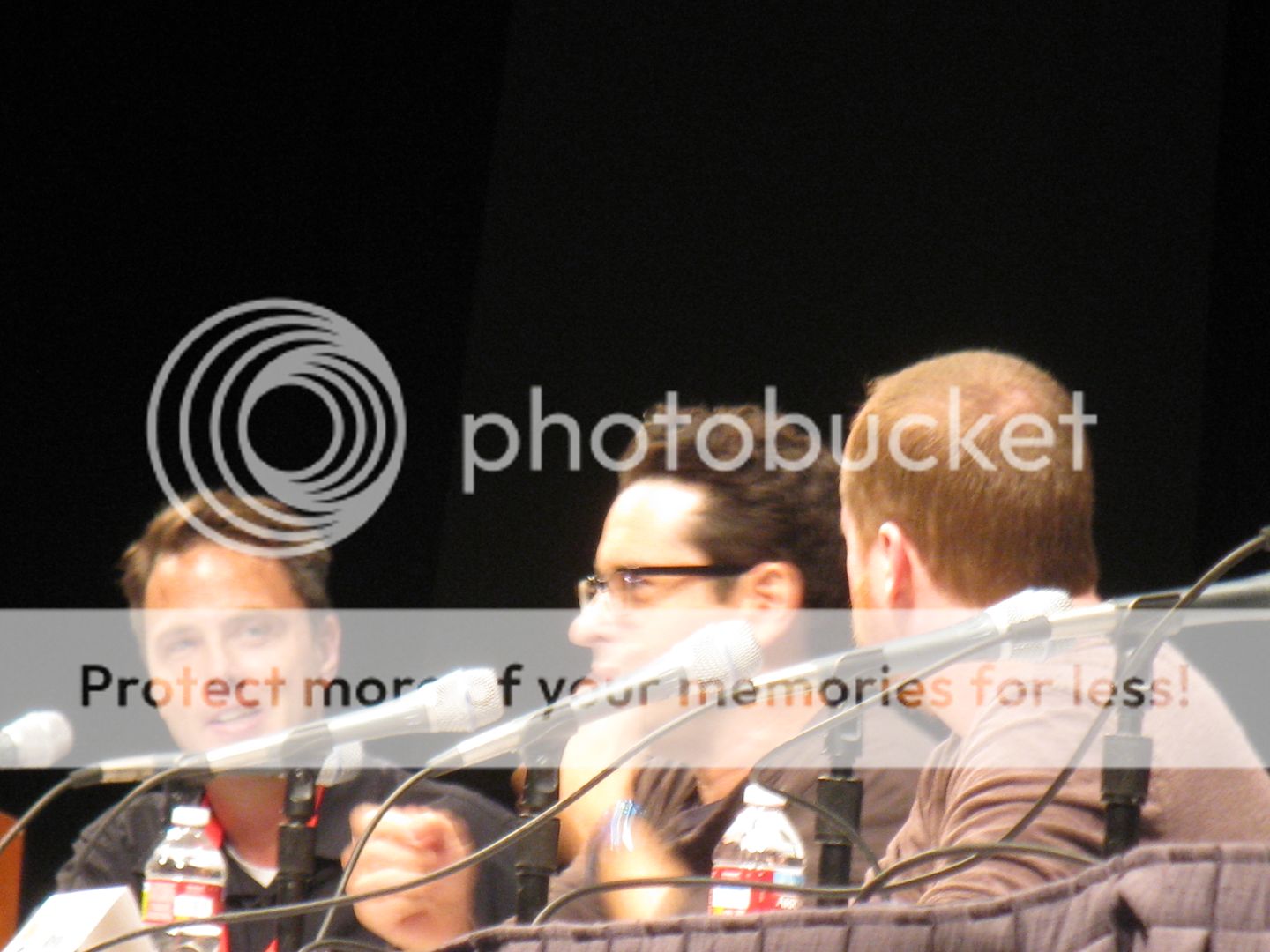
Both J.J. Abrams (Alias, co-creator of Lost, What About Brian?, Cloverfield) and Joss Whedon (Buffy the Vampire Slayer, Firefly) are rock stars in the world of television genre writing. So it would go without saying that their combined might upon one singular panel would cause another big bang, or the birth of a unicorn, or at least get a boatload of fans churned up to Twilight-levels of excitement. That was the feeling in the enormous venue Hall H: that the world would halt for a brief hour while these two decided how to continue shaping it. Well, unfortunately, no unicorns were birthed. Fortunately, it was still a good time. Instead of the melding of ideas and thoughts, it was more of a dinner between two famous film people that enjoyed answering questions specifically asked of or about them. They would occasionally reference that the other dinner guest was eating at the sane table, but other than that, it could have been a Joss Whedon panel followed by a J.J. Abrams panel.
The moderator opened it up with a hum-dinger, asking Whedon if he was indeed officially announcing that he would be directing Marvel’s superhero team flick, The Avengers. At first, Whedon said that there was no official word yet, but then he followed that by saying the official word. This, needless to say, got a gigantic response from the unfathomably-huge, wide, and deep crowd. Abrams had nothing new, but gave a movie story none-the-less: when he was a small child, one of the crew members from The Exorcist mailed him an actual tongue from the movie. It was in no way related to what Whedon had just announced, nor was it a movie announcement, but it somehow felt like it was contributing to the larger narration of the panel. Abrams was then asked about his infamous draft of Superman Returns, in which Krypton does not explode and Lex Luthor is an alien. “It was not well received” Abrams sheepishly said, referencing the fan-storm that had swept the internet mere hours after it was put online. Abrams followed that up with talking about how he managed to team up with Steven Spielberg for Super 8, his mysterious monster move that, even though a teaser has been released, is not yet filming. “I was told that Steven Spielberg made movies when he was my age,” Abrams began “so they asked me and my friend to clean up some of his old movies…. They have in-house studios for that sort of thing, and they paid us $300, and I knew why they did not do that”. He added that the film would not be in 3D.
Whedon stated that he was fine with 3D, as long as it was done well. He was also fine with 3D as long as it was not in his upcoming horror movie, Cabin in the Woods – which it is. “I love it, it puts you in the space… [but] the movie has to work in 2D” he said. Abrams revealed that he was still on the fence regarding the issue, “everything gets dim… it seems less.”
Before a rather banal question and answer session filled with every Whedon and Abrams fanboy imaginable, Whedon took the time to talk about Dr. Horrible 2, the much talked about sequel to Dr. Horrible’s Sing Along Blog. When discussing the project, which would continue the story set forth in his webseries created during the Writer’s Strike (and has since become the second Whedon-written musical to become a staple of Comic-Con). “I missed my window,” Whedon said, on the topic of digital media “I was waiting for people to show up to the party.”
Even though the Q&A session was quite lame, and I do not like Abrams, something spectacular happened at the very end of the panel. A young lady asked if criticism is ever okay for writers, since her brother recently asked for some and then shut himself off from her when he received it. This clearly made Abrams livid, as he asked for the man’s phone number. His intentions were clear. That’s when I finally found something I liked about Abrams. I connected with him as a writer and as a human being. In the big picture, that’s what these panels are for. Not to showcase new projects or to grandstand, but to connect.
From the Press Room: DEXTER
ScriptPhD.com was extremely fortunate to join producers and stars of SHOWTIME hit Dexter on their way to their Comic-Con panel. Here’s some dirt that we picked up! (We promise to catch up with Michael C. Hall, who was literally rushed out before our very eyes, back in Los Angeles in a separate post devoted entirely to Dexter.)

The production staff at Dexter is getting a shake-up. This year, they’ve added several new producers, including Tony Goldwin (pictured), who visited Comic-Con along with the old guard to give us some insight into things we can expect from the show this season. Part of the strategy of the “new energy” is a shake-up of the show itself. The producers wanted to avoid the “one season, one adversary” formula and recalibrate the show’s content while delivering the same pleasing product to the audience. So expect a lot of differences this year with what Dexter deals with and whom he battles with (if at all).
Unlike a lot of other shows adopting the popular meme of “skipping time” for resolution, Dexter will pick up right where we left off to get all the blowback over Rita’s death. And what a lot of blowback there is! The newest change, producers tell us, is that Dexter is feeling a new emotion for the first time… guilt. It’s something he’s never felt before and quite new for him. Much of this is because he was so hopeful as the season ended that things might actually be heading towards a positive change, that he might get rid of the dark passenger, he was looking forward to a honeymoon with Rita, only to come home and find her dead and his son in a pool of blood. Dealing with that will be very difficult for him, but the producers couldn’t tease us with more. On top of all of this, people are starting to figure his tendencies out, which adds yet another layer of complexity.
ScriptPhD.com asked about the forensics of the show and how they’re keeping it fresh. Said Producer Sara Colleton: “Well, we have an expert who works with us, and they’re the tech person. You just keep up to date with what is used by police. What we don’t do is CSI-style, flashy, make-believe forensics. I don’t know how to go in your nose and down your throat and find a bullet and say “Here it is!” We really try to play by the rules in terms of how long a DNA test takes, what the limitations of top forensics are. We want those things to be real, because the conceit of the show is so unreal, that we want everything else to feel real.”

Jennifer Carpenter (Deb Morgan) was very excited about Season 5’s changes, though she admitted that for the first time, she really didn’t know what was going to happen. In the beginning of the season, Deb hopes that she and Dexter have a certain kinship, because they’ve both experienced loss, but that isn’t quite what happens. She correctly noted something I’ve noticed a lot about Deb, which is that she does a lot of talking at Dexter, and not with Dexter, which leads to his typical one-word answers. Jennifer noted that a lot of times, women in particular are guilty of “filling in the blanks” with the stories we want to hear (guilty as charged!), which affects Deb’s relationship with Dexter. She felt a little pressure of Comic-Con, with such a concentration of die-hard fans that you have to please, but pointed out that this is also the great thing about Dexter; they hate you one week and love you the next. Jennifer also hinted at growing suspicion on Deb’s part about Dexter, who experiences his grief a lot differently than her, but that the sister part of her refuses to piece it together. We asked Jennifer about the growing stripping away of Deb’s vulnerability, and how much more of that we’ll see in the upcoming season, and frankly, what she thought of it as character growth. Here’s what she had to say:
“I have to say that last year, Keith Carradine (Lundy), his line “You’re confused, and now you’re not. We’ll figure it out together.” was the first time on the show that I’ve heard someone say (to Deb) I’m going to help you. And then immediately he’s dead. That one line helped me play [the character] for seven episodes. I think about it now and I could cry my eyes out. This year, I feel like it’s about standing up straight, choosing your words, how you enter a room, she’s not editing herself, but she’s calculating. She’s working like a cop. And a little less of a potty mouth.” But not too much, she promised us!
Finally, we are thrilled to publish an interview that we have teased you about long enough. As we await the yearly MythBusters panel, always a hit here in San Diego, we had the opportunity to get some pre-Comic-Con scoop from one of our favorite MythBusters about her new hosting adventure on the Science Channel. Check it out:
Interview with MythBusters’s Kari Byron
ScriptPhD.com: Head Rush will primarily be aimed at kid-enthusiastic presentations of science. How did your interest in hosting and putting this show come together?
Kari Byron: This has been a passion project that Debbie Myers [general manager of The Science Channel], The Science Channel and I have been talking about for a while. There is a disconnect at about the age of 12 where girls stop being interested in science. And we just wanted to figure out a way to get them, and obviously all kids around that age, interested in science in a way that they could be passionate about it as well. We figured if we could create a show that was cool, not talking down to them, we could keep that interest alive.
SPhD: You have a very non-traditional science background as a sculptor and painter. How important is it to you to convey that a layperson can have a healthy curiosity and passion about science?
KB: Well I obviously came to science a little later in life, and I think that’s why I have the same excitement that you’d have when you were a kid for it. I think having no science background makes it more accessible in the way that you don’t have to be a scientist to enjoy the science.
SPhD: This programs is affiliated with President Obama’s STEM initiative. You and I chatted a bit about girl power at the Discovery Channel 25th Anniversary party. What kind of responses do you get from girls that are fans of your work on MythBusters?
KB: It’s really cool! I talk to a lot of moms and teachers as well, and I get excited [that they use], I hate to use the word role model because I feel like I don’t deserve it, but it’s nice that they have a really positive response. They like seeing someone that’s more like them.
SPhD: What small sneak peek can you give us to tease fans during Comic-Con to get them super excited about watching the show?
KB: I’m actually so interested in the material that we’re doing, that I’m just amazed at the stories. We do a bunch of experiments that give a hands-on approach to science. [Head Rush] is so different from MythBusters that I can’t even compare it. We will be using clips from all the Discovery brand shows, and a lot of MythBusters, of course, but the Head Rush segment of it is its own beast. I don’t know who or what I can reveal!
There you have it folks! Kari is so excited about her new show, she is hard pressed to reveal any secrets to spoil it. We thank her and Discovery Channel for granting ScriptPhD.com a sneak preview. Head Rush will air on The Science Channel beginning August 23, Monday-Friday 4-5 ET/PT, and Saturdays, 7-9 AM ET/PT.
Comic-Con 2010 Costume of the Day: ….and the unanimous winner is…. Calendar Man! We gave points for creativity.


For a complete album of pictures from Comic-Con (and many of the costumes that didn’t quite make the running for Costume of the Day, take a look at our our Facebook fan page (and become a fan!).
~*ScriptPhD*~
*****************
ScriptPhD.com covers science and technology in entertainment, media and advertising. Hire our consulting company for creative content development.
Subscribe to free email notifications of new posts on our home page.
]]>
